
Get Placed With Our 7th Consecutive Batch
DevOps, DevSecOps With AWS Cloud & SRE
Free Demo Session On
#1 DevOps Trainer in Telugu. 9+ Years Industry Experienced Lead DevOps & SRE Engineer and Trained 1000+ Students and Get Placed 100+ Students
Seamless Integration with Your Favorite Tools

FREE DEMO
OCTOBER 26TH 2025 (SUNDAY) 10:30 AM IST
Know About Your Trainer
Prasanth Reddy, #1 trainer in telugu
I am Prasanth Reddy, a seasoned trainer
with over 9+ years of industry experience
in the fields of DevOps and Cloud
Technologies.

Industrial Experience
9+ years of industry experience in IT
and DevOps, Currently Working in Rakuten India, as a Lead DevOps & SRE Engineer

KK DevOps Founder, Trainer
Founder of the popular YouTube
channel KK FUNDA, with thousands
of subscribers and Trained 1000+ Students and Placed 100+ Students in Multiple Positions

Passion Towards Training
Passionate about mentoring and
helping individuals achieve their
career goals

Gate CS 3 Times Qualified
Qualified Gate CS 3 Consecutive Times, As A Computer Science Student.

CKA, AWS Certfied
A Certified Expert in Kubernetees CKA Test and also Amazon Web servies AWS Certified

Placement Track Record
Have a Track Record of Most Students Placed. Even a Fresher also got job as DevOps engineer
Why Choose Us Over Others
3 Things Beyond Just Training
Beyond Just Training Students, like others We have 3 Unique useful Features Which are the key for a student to got placed into a Good Environment With Decent Income.

Blogs Portal – Running Notes
Running notes, the same as in class. – Blog Portal
No Working Professional or employee have much time to take notes, for every session, but we know how important a running notes is, when we are attending an interview tomorrow to have a quick revision. so here is the solution to
Scenario Playground
Platform to Practice Scenario based Interview Questions
While Giving Interview Scenario based Questions Are Our Main Villians, so An interactive platform for mastering scenario-based interview questions.


Daily Job Updates Portal
No Need to Search SomeWhere Else – We Search for you.
We Daily Update Hand – Picked 20+ Jobs on an average every day. so you can happily apply for those jobs which cover wide range of Job categories.
So What I Learn in These 5 Months Extensive Training
You Got all these Skills in a 5 Months
5 Months is so Long, But When You got all these skills and tools, You will not feel That much long and boring.. Yeah That’s True.
DevOps Foundation Module
- Introduction to DevOps Concepts
- Understanding Software Development Life Cycle (SDLC)
- Waterfall Model in Traditional SDLC
- Agile Methodology Overview
- Scrum Framework Basics
- Sprint / Iteration Cycles in Agile
- Defining DevOps – A Cultural and Technical Shift
- Reasons to Choose DevOps – Key Drivers
- Significance of DevOps in Modern IT
- The DevOps Operating Model
- Stages in the DevOps Lifecycle
- Current Market Demand & Career Prospects in DevOps
- Overview of Commonly Used DevOps Tools
Linux
- Introduction to Linux Operating System
- Installing Required Software (SSH Tools and FTP Tools) on Desktop/Laptop
- Creating an AWS Account
- Launching an EC2 Instance in AWS
- Linux File and Directory Structure
- 100+ Linux Commands
Shell Scripting
Module 1: Shell Scripting Basics
- Introduction to Shell Scripting
- What is Shell?
- Types of Shells
- What is Shell Scripting?
- Writing Your First Shell Script
- Shell Script File Naming Conventions
Module 2: Scripting Elements
- Adding Comments in Scripts
- Working with Variables
- Command Line Arguments ($1, $2, $@, etc.)
- Escape Characters in Output
- String Handling Techniques
- Arithmetic Operations in Shell
Module 3: User Interaction
- Accepting Input with read Command
- Input & Output Redirection (>, >>, <, 2>)
Module 4: Control Flow
- if, else, elif Conditions
- for Loops
- while Loops
- case Statements (Switch-case style)
Module 5: Advanced Scripting
Using Pipes (|) for Data Flow
Shell Functions (Reuse Logic)
Git & Github
Module 1: Git & Version Control Basics
- What is Git?
- What is VCS (Version Control System)?
- What is SCM (Source Code Management)?
- Why Git is important in DevOps?
- Git Architecture
- What is Branch?
- What is Tag?
Module 2: GitHub Essentials
- Creating Account on GitHub
- GitHub vs Git (Key Differences)
- GitHub UI Overview
- SSH Key Generation
- PAT (Personal Access Token) Creation
- Cloning Repositories (From GitHub)
Module 3: Git Core Commands & Developer Workflow
- Git Initialization & Local Repo Setup
- Git Common Commands (init, add, commit, status, log)
- Cloning Remote Repositories
- Working with Git as a Developer
- Git Administration Tasks
- Git Configuration (user.name, user.email)
- README File Creation & Usage
Module 4: Git Collaboration & Workflow
- Forking a Repository
- Pull Requests (PRs)
- Merging Branches
- Conflict Resolution with Real-Time Examples
- GitHub API – Using Shell Script to Access GitHub
- Creating & Managing Issues in GitHub
Module 5: Git Branching Strategy
- Feature Branching
- feature/login-page, feature/cart-module
- Hotfix Branching
- hotfix/db-connection-error
- Release Branching
- release/v1.1, release/2025Q2
- Develop Branch Strategy (Git Flow)
- main → develop → feature
- GitHub Flow
- Create PR from branch → Code Review → Merge to main
- Trunk Based Development
- Frequent small commits to main with automation
- Environment Branching
- dev, qa, stage, prod
Module 6: Best Practices & Interview Preparation
- Git Ignore and Best Practices for Clean Code
- Branch Naming Conventions
- Writing Clear Commit Messages
- Difference Between reset, revert, checkout
- Interview Questions on Git/GitHub (Scenario Based)
- Real-Time Use Cases in CI/CD Pipelines
Maven Build Tool
Module 1: Introduction to Maven
- What is Maven?
- Why do we use Maven in Java Projects?
- Features and Benefits of Maven over manual build processes
- Comparison with other build tools (Ant, Gradle)
Module 2: Maven Installation & Setup
- Downloading Maven on Windows/Linux
- Setting Environment Variables (M2_HOME, PATH)
- Verifying Maven Installation using mvn -v
Module 3: Maven Project Structure
- Standard Directory Layout of a Maven Project
- Understanding src/main/java, src/test/java, and target/
- Role of pom.xml
Module 4: Maven POM File
- Understanding pom.xml structure
- Key Tags in POM: <groupId>, <artifactId>, <version>, <dependencies>, <build>
- Plugin and Dependency Management
Module 5: Maven Repositories
- Types of Repositories: Local, Central, Remote
- Maven Repository Lookup Mechanism
Module 6: Maven Build Lifecycle
- Default Lifecycle: validate, compile, test, package, verify, install, deploy
- Clean Lifecycle
- Site Lifecycle
Module 7: Hands-on with Maven
- Creating Maven Project manually and via mvn archetype
- Running Commands: mvn clean install, mvn package, mvn dependency:tree
- Understanding target/ Folder
Module 8: Multi-Module Maven Projects
- Parent POM configuration
- Inheriting configuration in Child POMs
- Best Practices for CI/CD pipelines
- Common Maven Interview Questions
Tomcat Server
Module 1: Introduction to Tomcat
- What is Tomcat?
- Use case of Tomcat in Java-based applications
- Difference between App Server and Web Server
- Understanding of Web Servers, App Servers, and Database Servers
Module 2: Tomcat Installation
- Tomcat Setup on Windows (Extraction Method)
- Tomcat Setup on Linux (Installation using tar or package manager)
- Setting Environment Variables (CATALINA_HOME, JAVA_HOME)
- Starting and Stopping the Server
Module 3: Directory Structure & Configuration
- Understanding Tomcat Directory Structure (bin, conf, logs, webapps)
- Changing the Default Port Number
- Understanding server.xml, web.xml, and context files
Module 4: User and Role Management
- Creating Admin and Manager Users in tomcat-users.xml
- Assigning Roles like manager-gui, admin-gui
- Security Considerations for Production Use
Module 5: Application Deployment in Tomcat
- Deployment through Admin Console UI
- Deployment via WAR File Drop in webapps/
- Auto-Deployment vs Manual Deployment
- Troubleshooting Deployment Issues
Module 6: Real-Time Use and Interview Readiness
- Hands-on Lab: Deploy Sample WAR File
- Common Issues and How to Fix Them
- Best Practices
- Tomcat Interview Questions & Real-Time Scenarios
Apache HTTP Server/ Nginix Server
Module 1: Introduction
- What is a Web Server?
- Why do we use Apache HTTP or Nginx?
- Difference between Apache and Nginx
- Use Cases in Real-Time Projects
Module 2: Installation
- Apache HTTP Server Installation (Linux/Windows)
- Nginx Installation Steps
- Verifying Installation using httpd -v / nginx -v
Module 3: Directory Structure
- Apache Directories (/etc/httpd/, /var/www/html/)
- Nginx Directories (/etc/nginx/, /usr/share/nginx/html)
- Configuration Files: httpd.conf, nginx.conf
Module 4: Starting the HTTP Server
- Start/Stop/Restart Commands for Apache & Nginx
- systemctl start httpd/nginx
- service apache2 restart
- Enabling HTTP Server on Boot
Module 5: Deploying Static Web Applications
- Hosting a Static Website with Apache
- Hosting a Static Website with Nginx
- Placing HTML/CSS files in Document Root
- Setting Permissions & Firewall Rules
SonarQube
Module 1: Introduction to SonarQube
- What is SonarQube?
- Why SonarQube is used in DevOps & CI/CD?
- Real-Time Use Case Overview
Module 2: Setup & Architecture
- Pre-Requisites (Java, Database, etc.)
- SonarQube Architecture
- Installation on Linux/Windows
- Changing the Default Port Number
- Start and Stop Services
Module 3: Running SonarQube
- Executing Code Scans
- Integrating with Build Tools (Maven/Gradle)
- Command-line Scanner Usage
Module 4: Administration & Configuration
- Creating Users (Normal and Administrator Roles)
- Creating and Managing Projects
- Deleting Projects Safely
- Token Generation for CI Tools
- Creating Custom Quality Profiles
- Defining Quality Gates
Module 5: Interview and Real-Time Use Cases
- What is SonarCloud?
- Real-Time CI/CD Integration Example
- Common Issues and Troubleshooting
- Important Interview Questions
Nexus Repository manager
Module 1: Introduction to Nexus
- What is Nexus?
- Role of Nexus in DevOps
- Real-Time Use Case Scenarios
Module 2: Installation & Initial Setup
- Installing Nexus on Linux/Windows
- Changing Default Admin Password & Email
- Email Server Configuration for Notifications
- Changing Port Number
- Changing Context Root
- Starting & Stopping Nexus Server
Module 3: Nexus Structure & Configuration
- Understanding Nexus Directory Structure
- Navigating the Nexus UI
- Nexus Configuration Files
Module 4: Repository Management
- Creating Repositories:
- maven2 (hosted)
- Docker Repository Setup
- Repository Purpose and Use Cases
Module 5: Integration & Automation
- Integrating Maven with Nexus
- Using Nexus as a Central Artifact Repository
- Nexus API Overview
Module 6: Policies & Access Control
- Creating Cleanup Policies
- Attaching Policies to Repositories
- Creating Users and Roles
- Assigning Privileges and Access Control
Module 7: Real-Time Practice & Interview Prep
- Common Issues & Troubleshooting
- Nexus vs Artifactory Comparison
- DevOps CI/CD Pipeline Integration
- Interview Questions & Answers
Jenkins
Module 1: Introduction to Jenkins
- What is Jenkins?
- Continuous Integration (CI)
- Continuous Delivery (CD)
- Continuous Deployment (CD)
- Real-Time DevOps Use Case Overview
Module 2: Jenkins Installation & Setup
- Installing Jenkins on Linux Server
- Initial Setup Wizard
- Plugin Installation
- Jenkins Directory Structure
Module 3: Job Creation & Maven Integration
- Create Maven Project using Freestyle Project Type
- Integrate Maven Software if Not Installed
- Integrate Nexus with Jenkins
- Integrate SonarQube with Jenkins
Module 4: Application Deployment
- Deploy App to Tomcat:
- Using “Deploy to Container” Plugin
- Using SSH Agent Plugin (Scripted)
- Configure Slack Integration
- Poll SCM (Git)
- Build Periodically (CRON)
- Trigger via Git WebHooks
Module 5: Build Management
- Discard Old Builds
- Disable/Enable Projects
- Delete Workspace Before Build Starts
- Add Timestamps to Console Output
- Use JACOCO Plugin for Test Coverage
Module 6: Jenkins Plugins & Management
- Plugin Management
- Safe Restart
- Next Build Number Control
- Email Extension Plugin
- SonarQube Scanner Plugin
- Artifactory Plugin
- BlueOcean
- Maven & Docker Plugin Integration
- Publish Over SSH / SSH Agent Plugin
- Thin Backup Plugin
- Build NameSetter Plugin
- Convert Freestyle to Pipeline Job
- Role-Based Authorization Strategy
Module 7: Security & Access Management
- Jenkins Security Setup
- Create Users (Default Admin)
- Provide Specific Access in Jenkins
- Assign Roles to Users
- Project-based Access Control
Module 8: Views, Parameters & External Tools
- Create View (List View, My View)
- Build with Parameters
- Port Number Change
- External Plugins Installation
- Urban Code Deploy Plugin
Module 9: Jenkins Pipelines (Scripted & Declarative)
- Create Pipeline Jobs:
- Scripted Syntax
- Declarative Syntax
- Add Parameters to Pipeline
- Upstream & Downstream Jobs
- Multibranch Pipeline Project Setup
- Use Shared Libraries
- Add Jenkinsfile to Project Repo
Module 10: Jenkins Administration & DevOps Real-Time
- CICD Implementation for Java Projects
- Master-Slave (Controller-Agent) Setup
- Jenkins Backup and Restore
- Jenkins Migration (New Server)
- More Examples on Declarative Pipeline Script
Ansible
Module 1: Introduction to Ansible
- What is Ansible?
- Why use Ansible in DevOps?
- Use Case Overview (Agentless Automation)
Module 2: Core Concepts
- Configuration Management Basics
- Ansible Features and Benefits
- Ansible Architecture (Control Node, Managed Nodes, Modules, Plugins)
Module 3: Inventory & Setup
- Host Inventory File (Static & Dynamic)
- Installing Ansible on Linux
- Verifying Installation
- Ansible Directory Structure
Module 4: Ansible CLI & Commands
- Commonly Used Commands (ansible, ansible-playbook)
- Inventory Testing
- Modules Overview (ping, copy, service, yum, apt)
Module 5: Ansible Playbooks
- Writing Your First Playbook
- YAML Basics
- Tasks, Modules, and Plays
- Tags and Selective Execution
- Handlers for State-Aware Actions
Module 6: Variables & Control Flow
- Group Variables and Host Variables
- Using vars, vars_files, and vars_prompt
- Loops (with_items, loop)
- Conditional Statements (when)
- Combining Loops and Conditions
Module 7: Security & Secrets
- Ansible Vault (Encrypting Sensitive Data)
- Creating and Using Vaulted Files
- Vault Password Management
Module 8: Roles and Reusability
- Ansible Roles Structure
- Converting Playbooks into Roles
- Using Roles in Real Projects
Module 9: Advanced Inventory Management
- Working with Dynamic Inventory
- Integration with AWS EC2 Inventory Plugin
Module 10: Real-Time Use & Interview Prep
- End-to-End Automation Example
- Common Errors and Troubleshooting
- Interview Questions on Ansible (Scenario Based)
AWS
Module 1: Introduction to Cloud & AWS
- Introduction to Cloud & Cloud Computing
- Cloud Service Models (IaaS, PaaS, SaaS)
- Types of Clouds (Public, Private, Hybrid)
- AWS Introduction & Its Global Architecture
Module 2: EC2 – Elastic Compute Cloud
- What is EC2?
- Launch Our First EC2 Instance – Part 1 & Part 2
- How to Use PuTTY/GITBASH/etc (Windows Users Only)
- Security Groups
- Elastic Volumes, Instance Stores
- EC2 Instance Metadata
- Amazon Machine Images (AMI)
- Public IP, Private IP, Elastic IP
- EC2 Summary
Module 3: EBS & EFS – Storage Services
- Introduction to EBS
- EBS Snapshots
- Create and Attach Additional EBS Volumes
- EBS Snapshot Manager
- Elastic File System (EFS)
Module 4: S3 – Simple Storage Service
- S3 Essentials
- Creating a Bucket Using Console
- Storage Classes and Lifecycle Management
- S3 Versioning and Version Control
- Cross Region Replication
- Glacier, Snowball, and Archival Storage
- S3 Security and Permissions
- S3 Summary
Module 5: VPC – Virtual Private Cloud
- What is VPC?
- Custom VPCs – Part 1 & Part 2
- Public & Private Subnets
- NAT Gateway, Internet Gateway
- Network ACLs and Security Groups
- VPC Peering and Routing
- VPC Summary
Module 6: Load Balancing & Auto Scaling
- Elastic Load Balancer (ELB)
- Network Load Balancer (NLB)
- Web Application Load Balancer
- Auto Scaling Groups
Module 7: Route 53 & DNS Services
- What is Route 53?
- Registering Domain
- Creating Hosted Zones
- Routing Policies
Module 8: IAM – Identity Access Management
- IAM Introduction
- Users, Groups, Roles, Policies, Permissions
- IAM Best Practices
- MFA, Password Policy
- Policy Simulator
Module 9: AWS CLI
- Installing and Configuring CLI
- Running EC2, S3, IAM, and VPC Commands from CLI
- Profile Setup and Access Keys
Module 10: Containers & Orchestration
- Elastic Container Registry (ECR)
- Elastic Kubernetes Service (EKS)
Module 11: Real-Time Projects & Interview Readiness
- CI/CD Project with EC2 + S3 + IAM
- Multi-Tier Architecture Deployment
- Troubleshooting Common AWS Issues
- AWS Interview Questions (Scenario Based)
Docker
Module 1: Docker Basics & Concepts
- Docker Introduction
- Containerization vs Virtualization
- Docker vs Virtual Machine
- Use Cases of Docker in Real Projects
- Before Docker and After Docker
Module 2: Installation & Architecture
- Installing Docker on Linux/Windows
- Docker Architecture: Docker Engine, CLI, Daemon, REST API
- Docker flow
Module 3: Docker Commands
- Basic Adhoc Commands (run, ps, exec, logs, etc.)
- Managing Containers and Images
- Working with Docker CLI
Module 4: Dockerfile & Image Creation
- What is a Dockerfile?
- Dockerfile Keywords (FROM, RUN, COPY, CMD, ENTRYPOINT, ENV, VOLUME, many more)
- Building Custom Docker Images
- Real-Time Dockerfile Examples
Module 5: Docker Objects
- Docker Images
- Docker Containers
- Docker Networks (bridge, host, overlay)
- Docker Volumes (bind mount, volume)
Module 6: Docker Registries
- What are Docker Registries?
- Using Docker Hub
- Using AWS ECR
Module 7: Docker Compose
- Introduction to docker-compose.yml
- Defining Multi-Container Applications
- Running Compose Projects (up, down, logs)
- Real-Time Example: Web + DB App Using Docker Compose
Module 8: Real-Time Scenarios & Interview Prep
- Common Docker Issues and Troubleshooting
- Docker Cleanup & System Prune
- Docker Logs and Monitoring
- Top Interview Questions on Docker (Scenario Based)
Kubernetes
Module 1: Introduction & Architecture
- Kubernetes Introduction
- Kubernetes Architecture
- Kubernetes Cluster (Self-Managed) Setup Using Kubeadm
- Kubernetes Namespace
- Kubernetes Objects Overview
Module 2: Core Kubernetes Resources
- POD
- Replication Controller
- Replica Set
- Daemon Set
- Deployment
- Rolling Update
- Recreate Strategy
- Stateful Set
Module 3: Storage & Configuration Management
- Service
- Persistent Volumes
- Persistent Volume Claim
- Dynamic Volumes
- ConfigMaps & Secrets
Module 4: Monitoring & Autoscaling
- Horizontal Pod Autoscaler (HPA) & Metrics Server
- Liveness & Readiness Probes
Module 5: Scheduling & Node Maintenance
- Node Selector
- Node Affinity
- Pod Affinity & Anti-Affinity
- Taints & Tolerations
- Cordon / Drain / Uncordon
- Scheduling Strategy Overview
Module 6: Security, Quotas, & Networking
- Resource Quota & Limit Range
- Network Policies
- Kubernetes RBAC (Role-Based Access Control)
Module 7: Cloud Kubernetes & Load Balancing
- EKS Kubernetes Cluster Setup
- Load Balancer Service
- Ingress Controller & Ingress Resource
Module 8: CI/CD & Helm
- Deploy Application Using Jenkins (CI/CD Integration)
- Helm: Package Manager for Kubernetes
Module 9: Observability
- Monitor Kubernetes Using Prometheus and Grafana
- Log Aggregation Using EFK Stack (Elasticsearch, Fluentd, Kibana)
Module 10: Real-Time Scenarios & Interview Prep
- Troubleshooting Common Kubernetes Issues
- Real-World Project Use Cases
- Kubernetes Interview Questions (Scenario Based)
Terraform With AWS
Module 1: Introduction to Infrastructure as Code (IaC)
- Traditional Infrastructure Challenges
- What is IaC & Why Terraform?
- IaC vs Configuration Management Tools (Ansible, Chef)
- Introduction to HCL (HashiCorp Configuration Language)
Module 2: Terraform Installation & Setup
- Install Terraform on Linux, Windows, Mac
- CLI Commands & Versioning
- Terraform vs CloudFormation vs Pulumi
Module 3: Terraform Core Blocks
- terraform Block
- provider Block (with AWS)
- resource Block
- variable Block (input, output, locals)
- data Block
- module Block
- referencing resources
Module 4: Working with Resources
- Resource Syntax and Arguments
- Resource Meta-Arguments:
countdepends_onfor_eachlifecycle
Module 5: Variables & Outputs
- Input Variables:
- CLI variables
.tfvarsandauto.tfvars- Environment variables
- Lists, Maps, and Complex Variables
- Sensitive Data Handling
- Output Values
Module 6: Data Sources
- Using
datablock to reference existing infrastructure - AWS Data Sources (AMI, VPC, Subnets, etc.)
Module 7: Expressions & Functions
- Built-in Functions (lookup, join, length, etc.)
- Dynamic Expressions
- Conditional Expressions and Loops
Module 8: Provisioners & Null Resources
local-execandremote-exec- Use of
null_resourcefor triggers
Module 9: Dynamic Blocks
- Dynamic Blocks Syntax
- Use Case Examples
Module 10: Terraform State Management
terraform.tfstate&state.lock- Local vs Remote State
- State Backends (S3 with DynamoDB Locking)
- State Commands (
list,show,rm,mv)
Module 11: Terraform Modules
- Create & Use Local Modules
- Modules from Terraform Registry
- Reusability and Best Practices
Module 12: Workspaces
- Default vs Named Workspaces
- Workspace Isolation and Management
Module 13: Terraform Cloud (Intro Only)
- Terraform Cloud vs CLI
- Remote Runs, State Storage, VCS Integration
Module 14: Real-Time CI/CD Integration
- Automate Terraform with GitHub Actions
- Jenkins + Terraform Pipeline
- One End-to-End Infrastructure Use Case
Module 15: Practice & Interview Readiness
- Common Errors & Troubleshooting
- Real-Time Scenarios
- 20+ Interview Questions with Solutions
Monitoring Tools ( NewRelic/ Grafana /Prometheus
Monitoring Tools ( NewRelic/ Grafana /Prometheus
DevOps Master Program Highlights
- Interview Preparation From Day 1
- Daily Stand-Up Calls
- 24/7 Trainer Support
- Real-Time Projects
- Hands-on-Learning
- Daily Job Alerts
Add – On Tools
- GitHub Actions
- Argo CD
Hands-On Projects
Real- Time E-Commerce Application End-To-End Setup Using DevOps Tools
Our Placed Students
May Be You Are The Next Person to be Featured Here
These are the persons who are placed by 5 Months Extensive Job Oriented Training
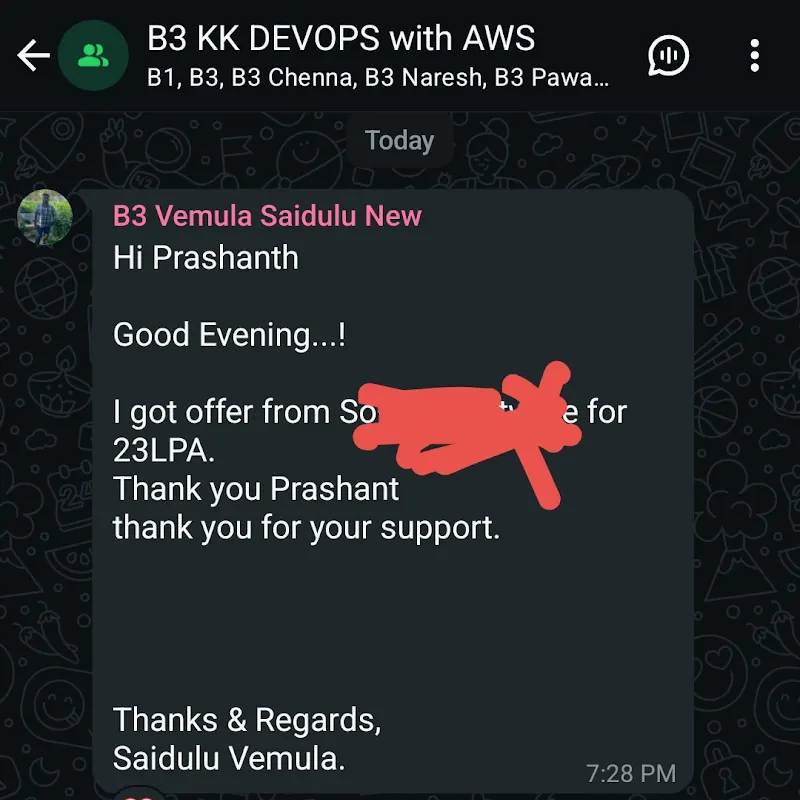
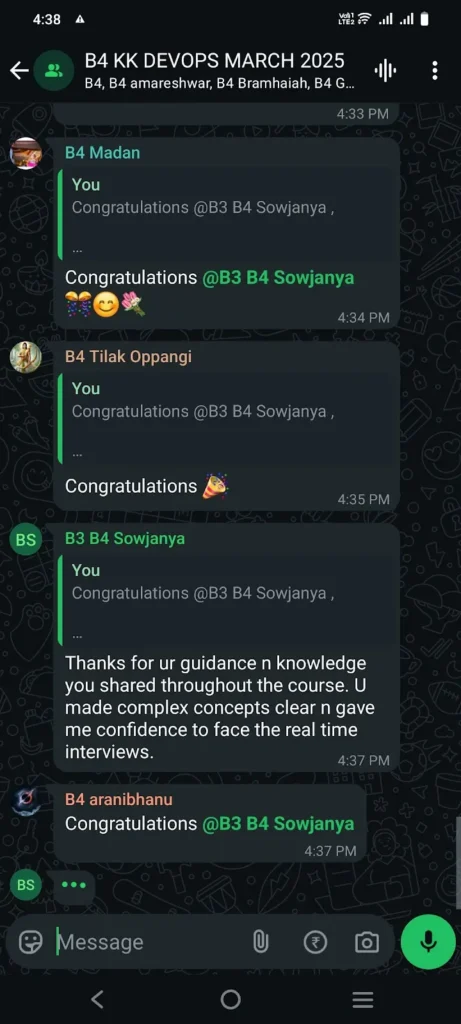
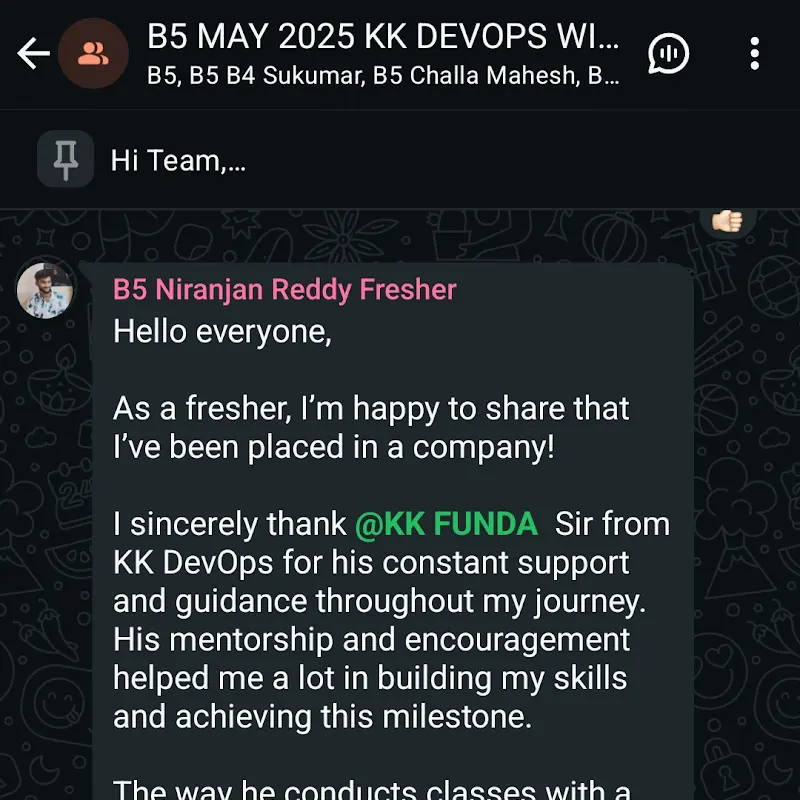
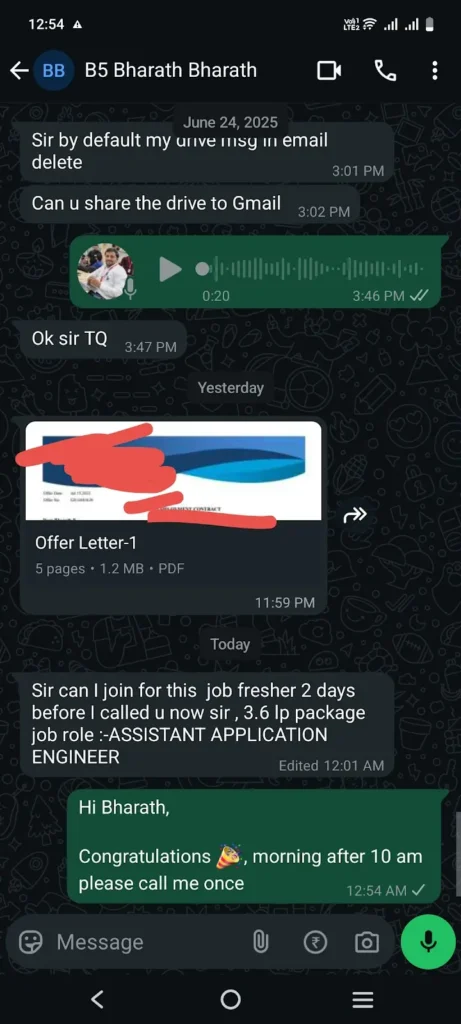
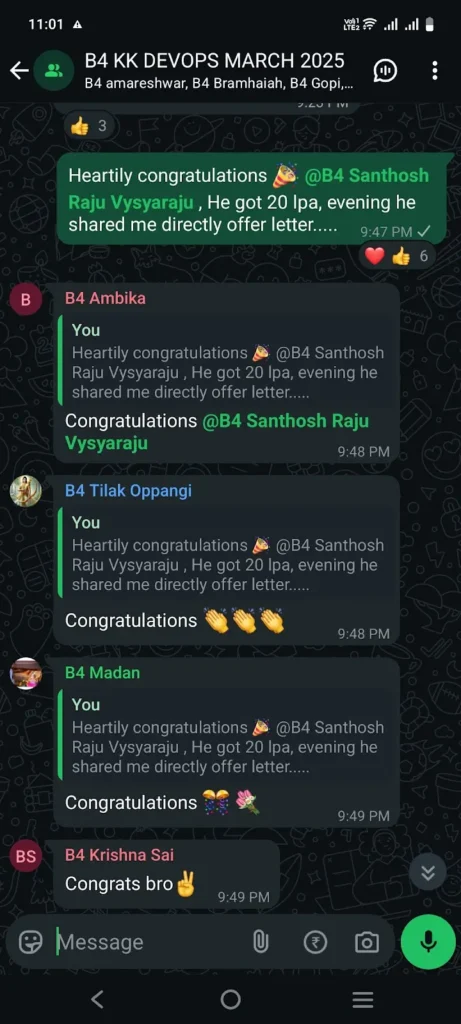
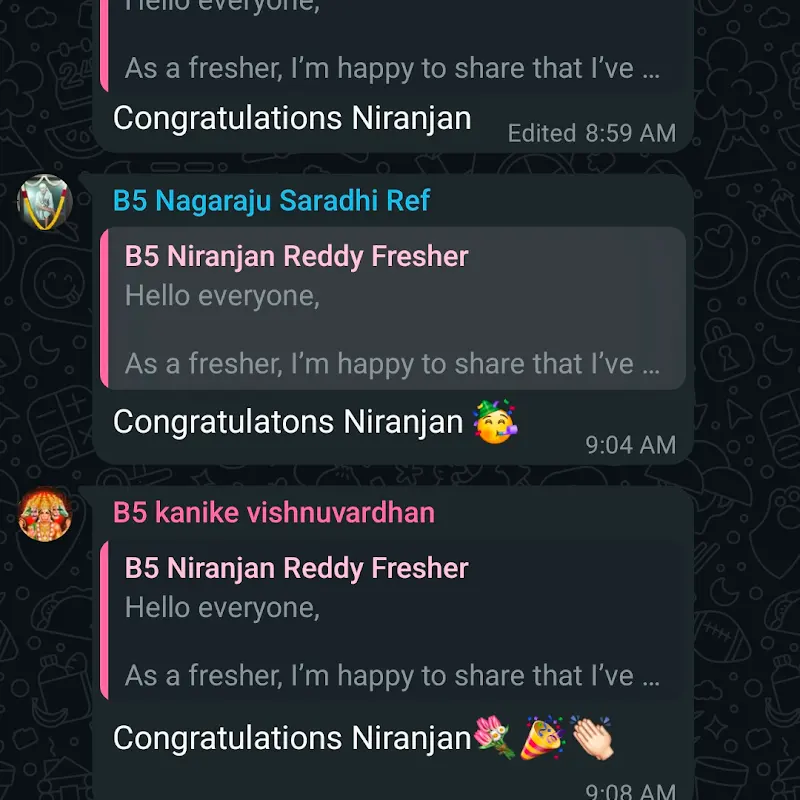
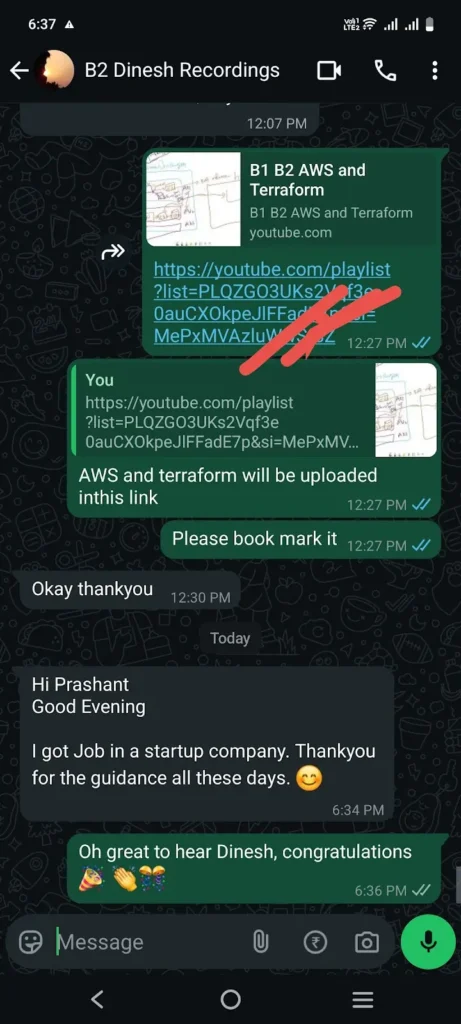
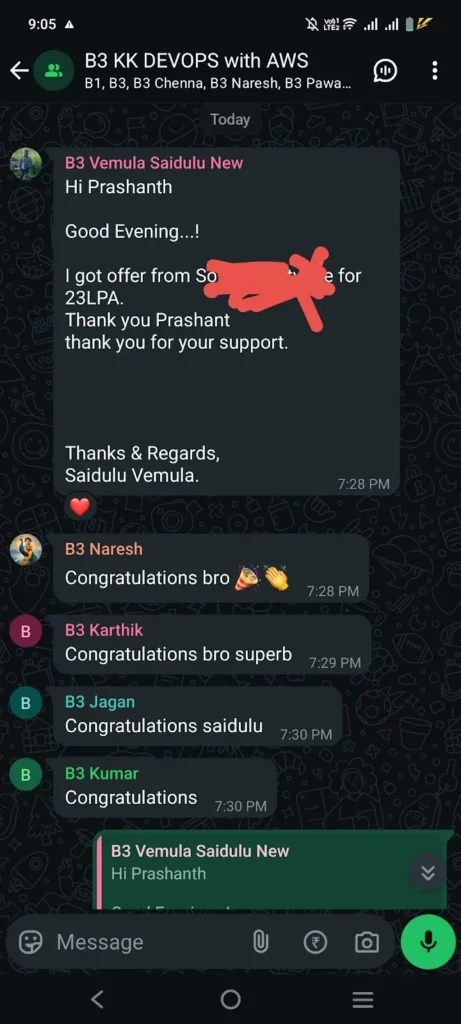
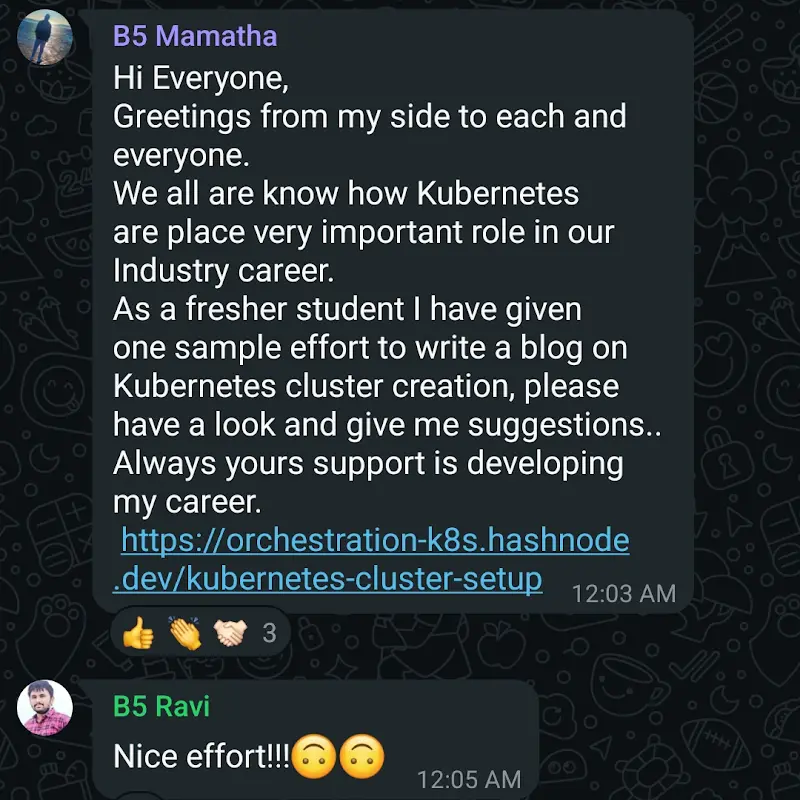

If You Enrolled Before Demo Session Starts You will Get Flat ₹1000 Discount
Just See About KK Funda in all platforms and Explore About Us, then Only Proceed With Us.



















